
Switzerland - Zentralbahn
For a full scale picture, please click on the picture shown !
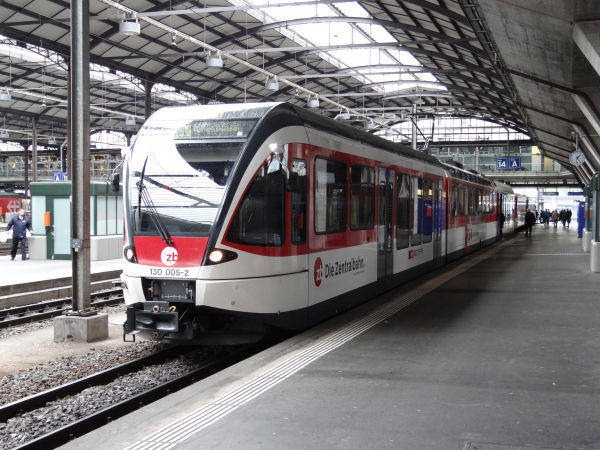
The company Zentralbahn ZB came into existence in 2005 as a fusion product of the private LSE Luzern-Stans-Engelbergbahn and the
SBB Brünigbahn, which was a part of the federal Swiss railways SBB. They both operated on a meter gauge network, partly three rail
cogwheel. At the city of Luzern they shared a common part of track from Luzern to Stansstad. LSE's line continued from there to the
famous skiing resort of Engelberg, whereas Brünigbahn's line climbed over the mountains via the Brünig pass and continued all the way
to Interlaken. Now as Zentralbahn these two companies have continued as one. A lot of renewal work has been done. Very expensive track
renewals happened at the former LSE line, including the construction of a new over 4 km long tunnel, the Grafenort to Engelberg tunnel,
and Zentralbahn has also almost completely gotten rid of their old trains, replacing them
with a more standardised fleet of electric multiple units built by Stadler. Flat land services close to the city of Luzern are served
by trains of the type SPATZ, which has large panorama windows. Lines climbing high up to Engelberg or over the Brünig pass are served
with three rail cog wheel capable units called ADLER (a seven coaches long train) or FINK (a three coaches long fixed train).
This is a three coach Stadler SPATZ class ABe 130 train with some extra old coaches fitted at the end, here ready to leave from Luzern
towards the former LSE line to Engelberg.
Picture from Luzern 1.5.2016 by Ilkka Siissalo.
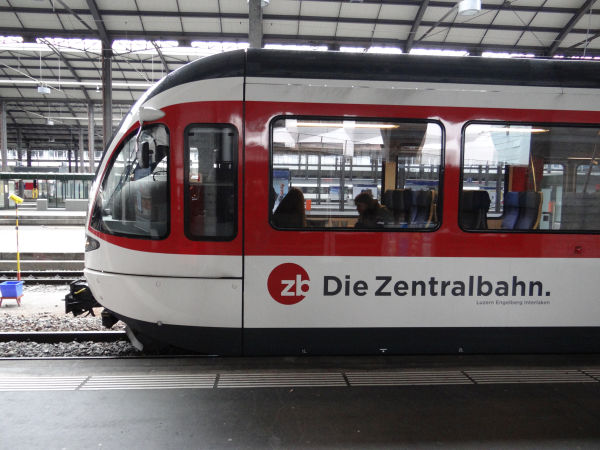
The same train as above. The driver's cab of a Stadler SPATZ is very similar to the ones of Stadler's GTW or FLIRT trains, but it
is shorter.
Picture from Luzern 1.5.2016 by Ilkka Siissalo.
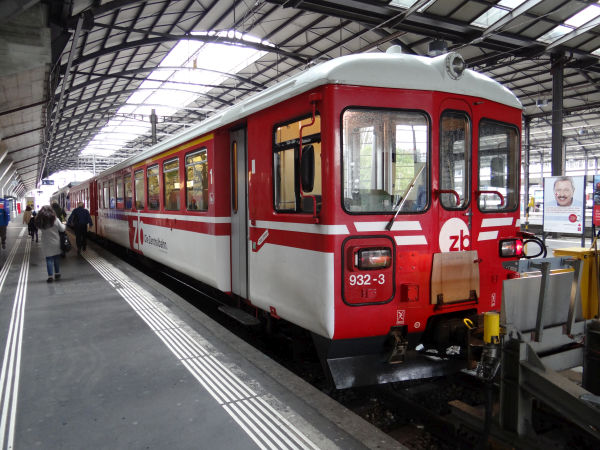
Still the same train as above. When the capacity of one three coach SPATZ unit was not enough, two old but renovated formerly LSE coaches
one of which has a driver's cab were added to form a longer rush hour train.
Picture from Luzern 1.5.2016 by Ilkka Siissalo.
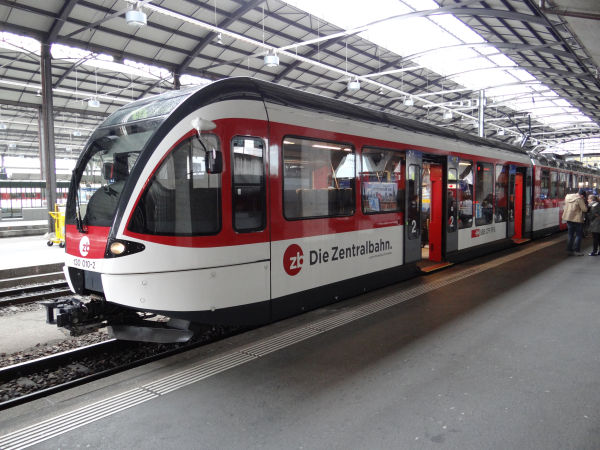
Another class ABe 130 SPATZ three coaches long train.
Picture from Luzern 1.5.2016 by Ilkka Siissalo.
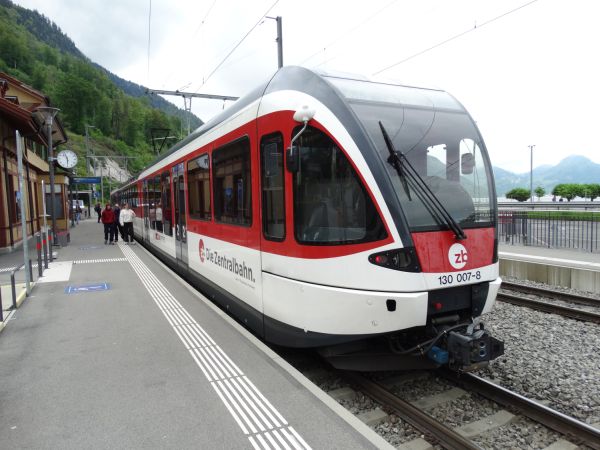
One of the ABe 130 SPATZ trains stopping at Alpnachstad station.
Picture from Alpnachstad 13.5.2023 by Ilkka Siissalo.
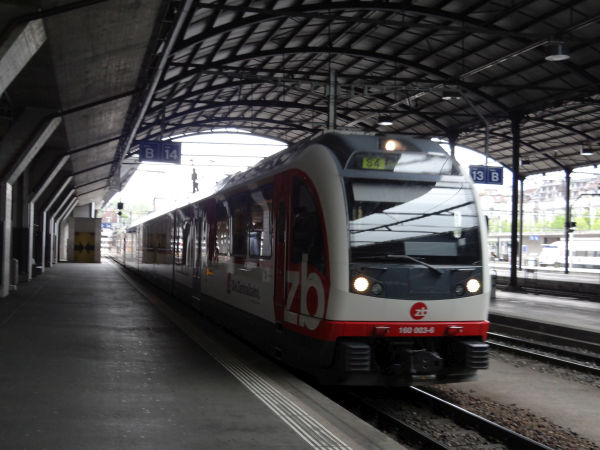
A three coaches long class ABeh 160 FINK train is arriving at the station of Luzern.
Picture from Luzern 1.5.2016 by Ilkka Siissalo.
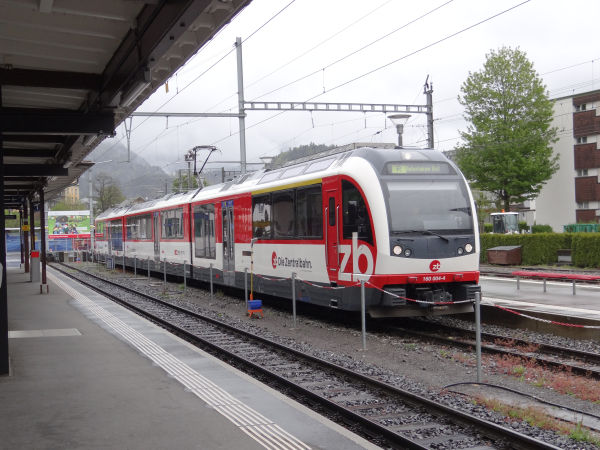
The flatland route section from Interlaken Ost to Meiringen has a frequent service which is normally served by the class
130 trains which have no cog wheel third rail systems. But sometines - like here - also this short route is run by ABeh 160
FINK trains, which actually do have the mountain line equipment not needed on this part of the line.
Picture from Meiringen 1.5.2016 by Ilkka Siissalo.
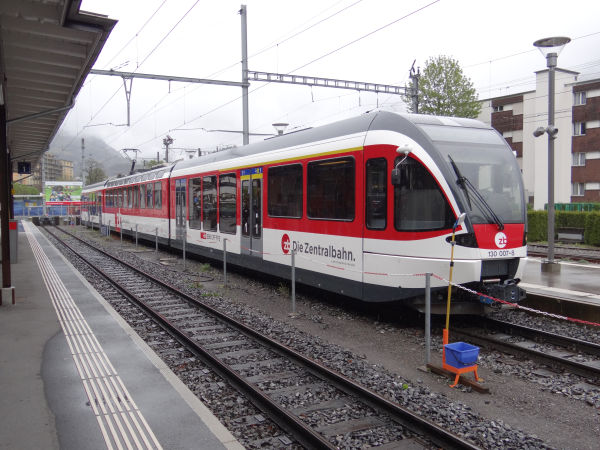
The next train on the same flatland route from Meiringen to Interlaken Ost was a class ABe 130 SPATZ.
Picture from Meiringen 1.5.2016 by Ilkka Siissalo.
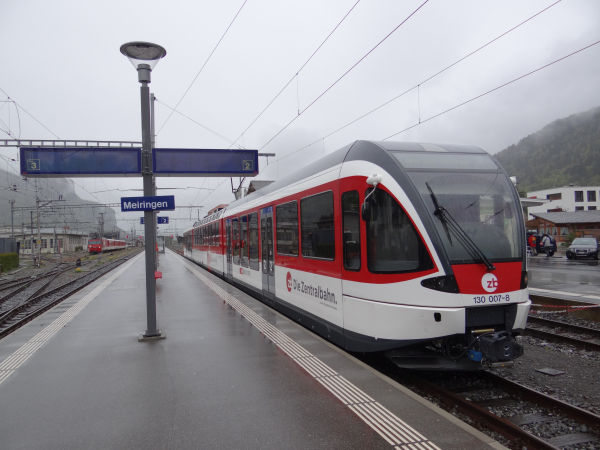
The same train as above, but seen from the other side. A class ABe 130 SPATZ.
Picture from Meiringen 1.5.2016 by Ilkka Siissalo.
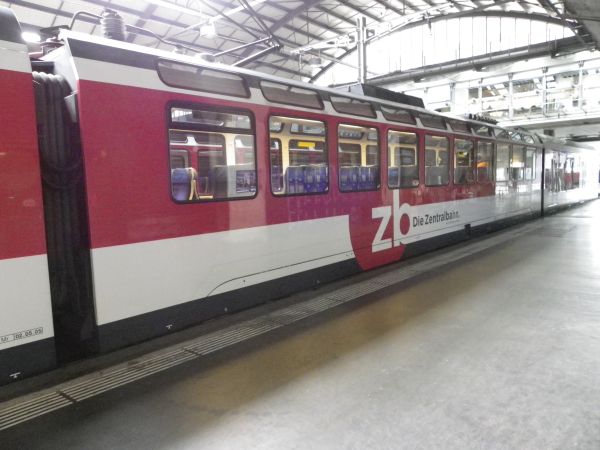
A middle coach of a SPATZ train has no doors towards the outside, but it has extra panorama windows on its roof enabling
the passengers to better enjoy majestic mountain views.
Picture from Luzern 10.7.2010 by Ilkka Siissalo.
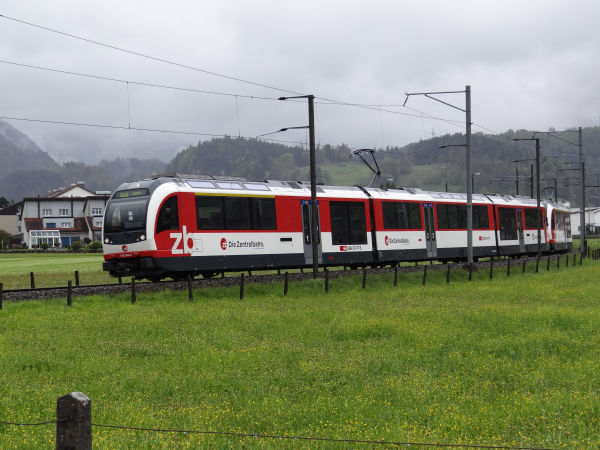
Zentralbahn InterRegio service from Interlaken to Luzern is approaching the station of Meiringen. The train is composed of
two class ABeh 160 FINK three coach units.
Picture from Luzern 1.5.2016 by Ilkka Siissalo.
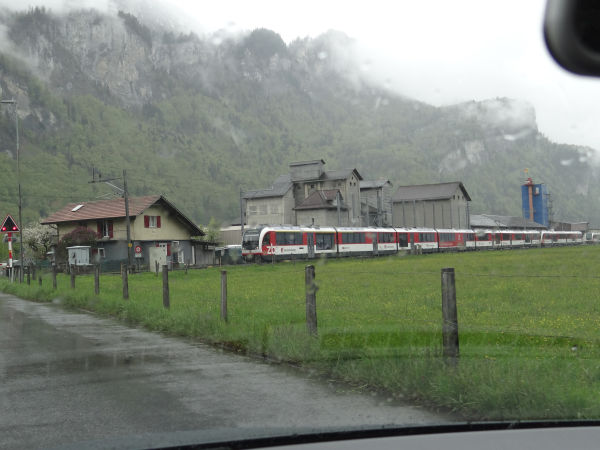
An InterCity train composed of a seven coaches long Stadler ADLER plus a three coaches long Stadler FINK unit is approaching
a road crossing on a rainy day and will soon reach Meiringen station.
Picture from Meiringen 1.5.2016 by Ilkka Siissalo.
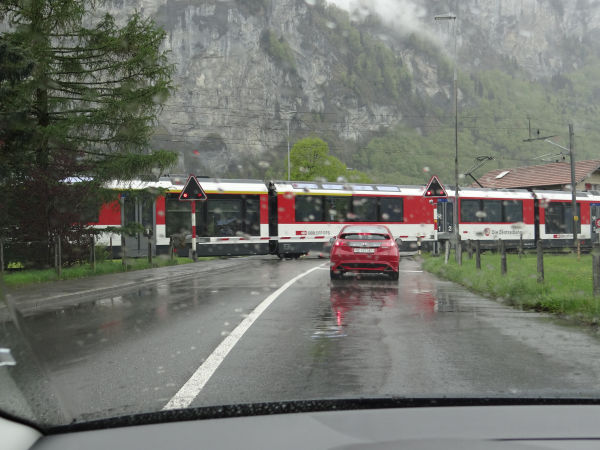
Same train as above. The ADLER unit is just at the level crossing.
Picture from Meiringen 1.5.2016 by Ilkka Siissalo.
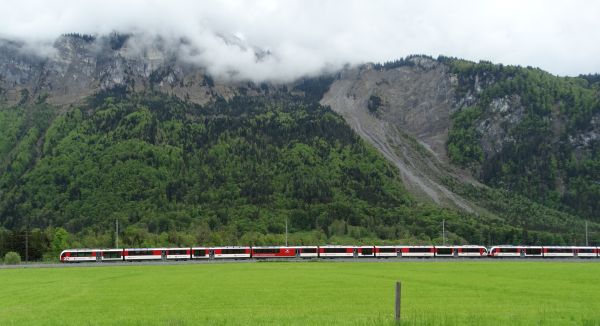
A similar train like the one above. This is the so called Luzern-Inerlaken Express consisting of an ADLER unit and a FINK unit.
Picture from near Brienz 13.5.2023 by Ilkka Siissalo.
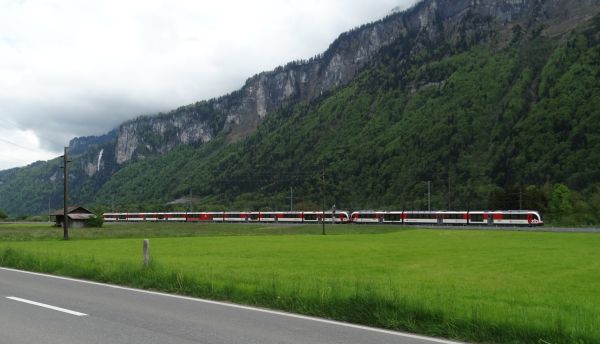
The same train as above. It's a long composition.
Picture from near Brienz 13.5.2023 by Ilkka Siissalo.
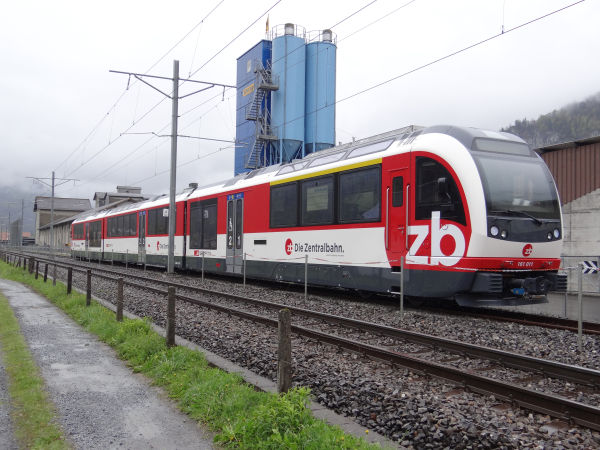
A class Abeh 161 Stadler FINK train, totally brand new and here still not even officially received from the manufacturer Stadler
to Zentralbahn. This new train is from the second generation of FINK trains. The second series has so many improvements over the
first one that it was classed as class 161 instead of the original class 160.
Picture from Meiringen 1.5.2016 by Ilkka Siissalo.
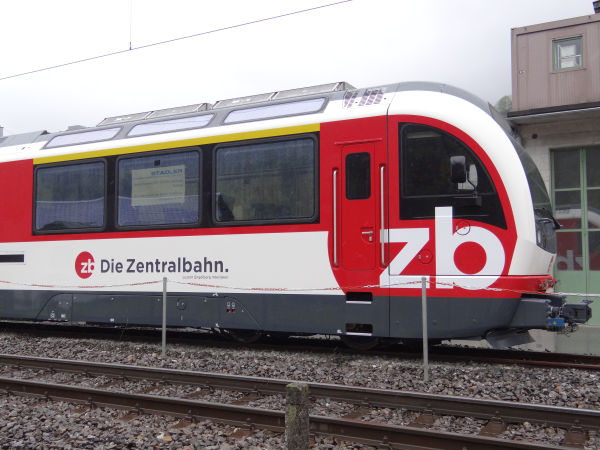
A closeup of the front of the same brand new FINK as above.
Picture from Meiringen 1.5.2016 by Ilkka Siissalo.
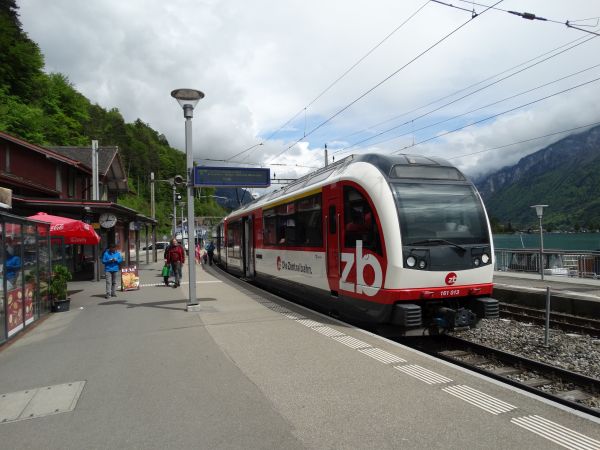
An InterRegio service from Meiringen to Interlaken served with a new FINK unit of class 161 is here stopping at the station of Brienz.
Picture from Brienz station 13.5.2023 by Ilkka Siissalo.
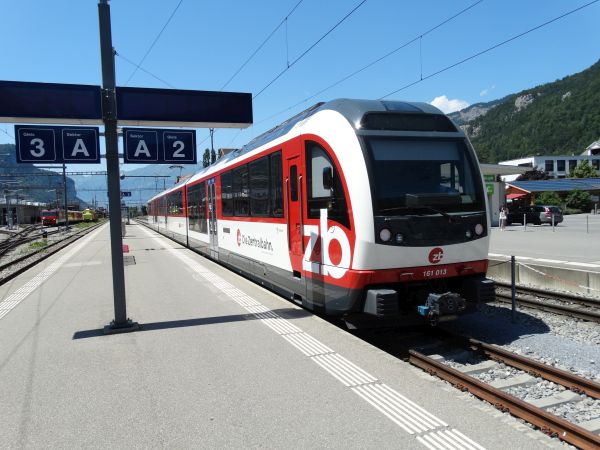
A Stadler FINK ABeh 161 at the Meiringen station. Both the series ABeh 160 and 161 are called FINK, but the 161 series trains are slightly
newer and have some improvements, for example bigger wheels and a modified cog wheel machinery., Zentralbahn has six series 160 trains and
five newer class 161 trains.
Picture from Meiringen 11,7.2023 by Ilkka Siissalo.
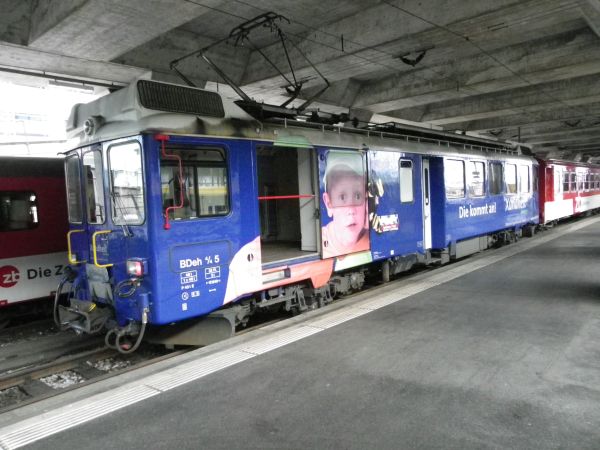
In addition to the new ADLER, FINK and SPATZ trains Zentralbahn still has also some older trains. This BDeh 4/4 no.5 is one of the
former LSE trains. It's currently used as a spare reserve. At the time when this photo was taken, the motorwagon was fully covered
by advertisement tapings.
Picture from Luzern 10.7.2010 by Ilkka Siissalo.
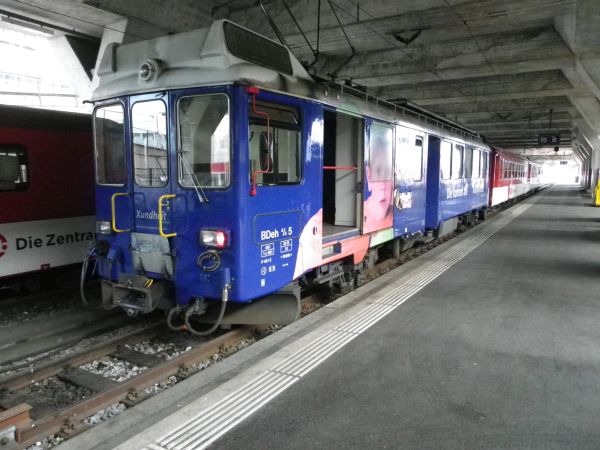
A second picture of the same train to better show its front. These motorwagons were built between 1964 and 1980 and there were eight
of them altogether. Three of them were broken to pieces until 2014 and one was sold. The rest may still remain at Zentralbahn (?)
Picture from Luzern 10.7.2010 by Ilkka Siissalo.
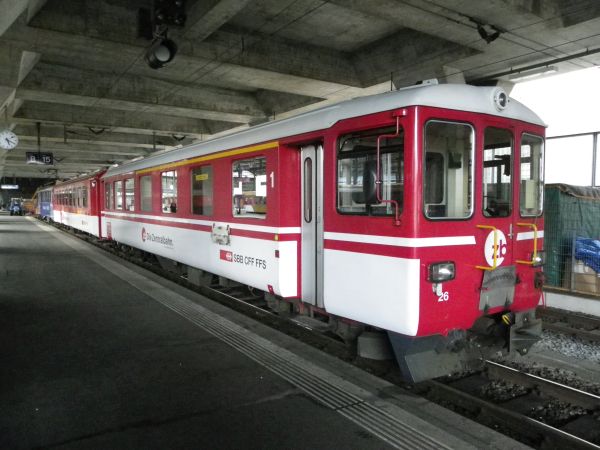
The other end of the same train, a steering cab coach carrying the number 26, now in Zentralbahn's colours.
Picture from Luzern 10.7.2010 by Ilkka Siissalo.
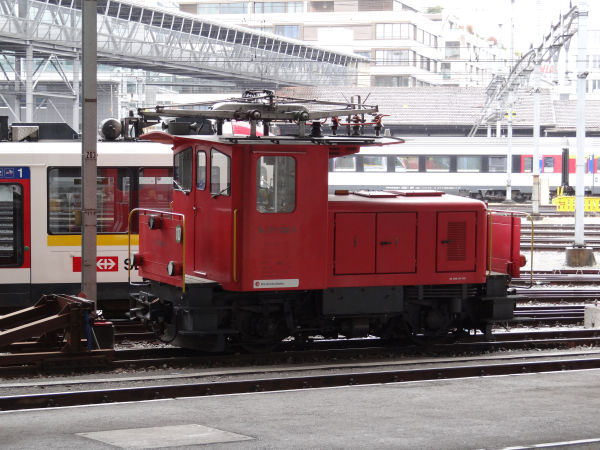
Electric cog wheel rail tractor Zentralbahn Te 171 still before its modernisation. It is of the type Te III and it was built by
SLM and SAAS in 1962. In 2011 this same machine was like brand new, all renovated and carried the emblem and name of the town of
Meiringen.Its max speed is 60 km/h, it weighs 26 tons and has a power rating of 257 kW. It works with 1,5 kV DC as is customary
at the Zentralbahn.
Picture from Luzern 1.5.2016 by Ilkka Siissalo.
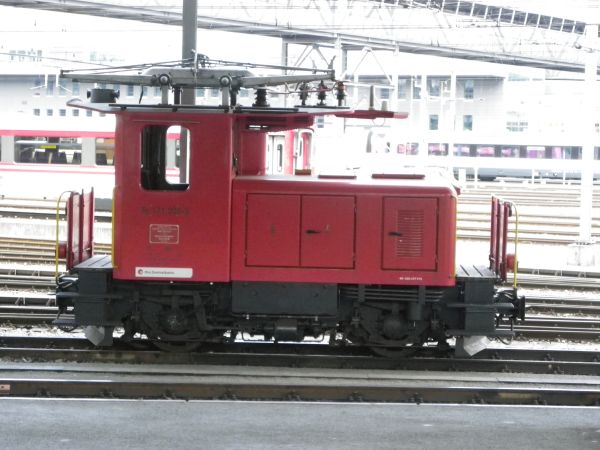
Another picture which shows a bit better how the Te 171 (earlier Te III) electric switcher tractors looked like.
Picture from Luzern 10.7.2010 by Ilkka Siissalo.
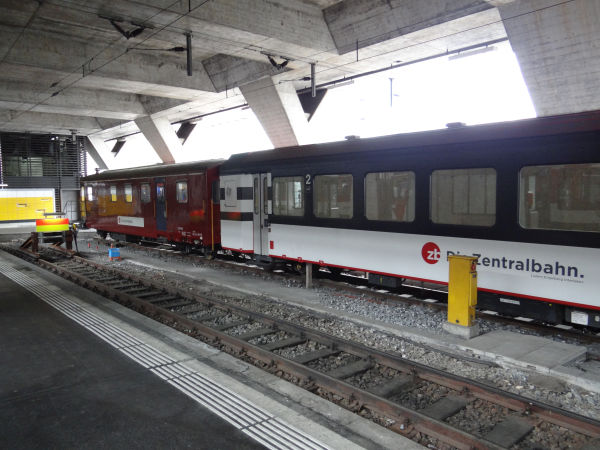
Old Brünigbahn's coaches act as a cafeteria and waiting room for Zentralbahn's personnel in Luzern.
Picture from Luzern 1.5.2016 by Ilkka Siissalo.
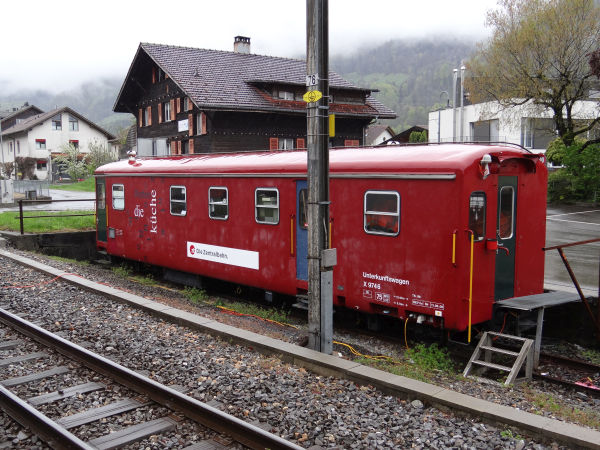
"Die Küche" = the kitchen. Another old Brünigbahn coach which now acts as a canteen and social room for Zentralbahn's workers.
Picture from Meiringen 1.5.2016 by Ilkka Siissalo.
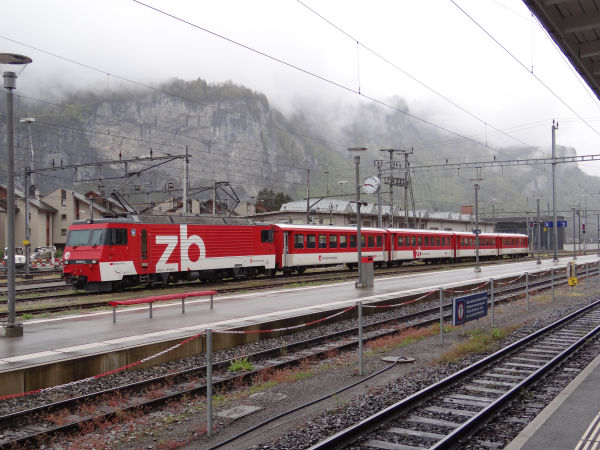
In the old Brünigbahn times this HGe 101 locomotive and its old coaches was the newest and finest that there ever was. But now the
locomotive and its set of coaches is just a reserve that would jump in as a replacement, should some one of the new Stadler trains
fail for some reason.
Picture from Meiringen 1.5.2016 by Ilkka Siissalo.
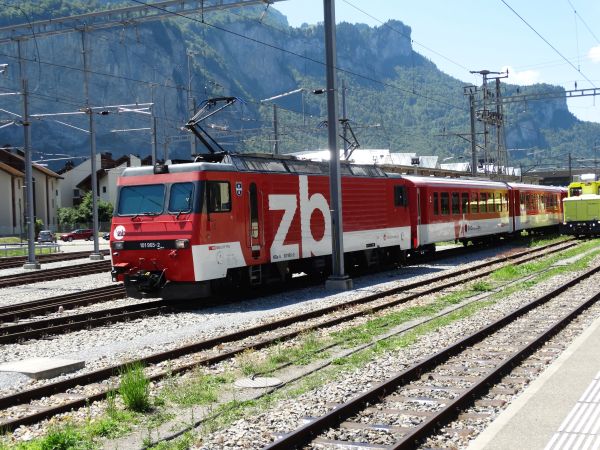
Zentralbahn's reserve train, a HGe 101 locomotive with old lightweight metal coaches waiting at the depot in Meiringen, ready to
jump in at any minute if there would be a need.
Picture from Meiringen 11.7.2023 by Ilkka Siissalo.
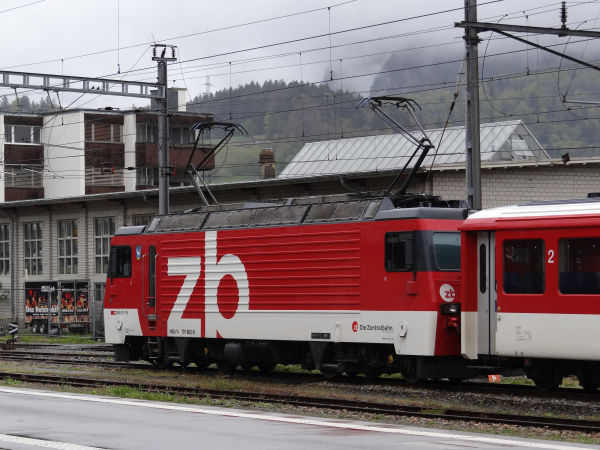
The HGe 101 (sometimes also referred to as HGe 4/4 101 or simply as HGe 4/4) was built for the companies Furka-Oberalpbahn FO (now a part of Matterhorn-
Gotthardbahn MGB), Brig-Visp-Zermattbahn BVZ (now also a part of MGB) and SBB Brünigbahn, now a part of Zentralbahn. There were 5
prototypes and 16 production series locomotives and they were first run in 1985. FO/BVZ/MGB machines run on 11 kV AC and these SBB
Brünigbahn/Zentralbahn machines on 15 kV 16,7 Hz. Their top speed on adhesion lines on flat land is 100 km/h and 40 km/h when using third
rail cog wheel drive.
Picture from Meiringen 1.5.2016 by Ilkka Siissalo.
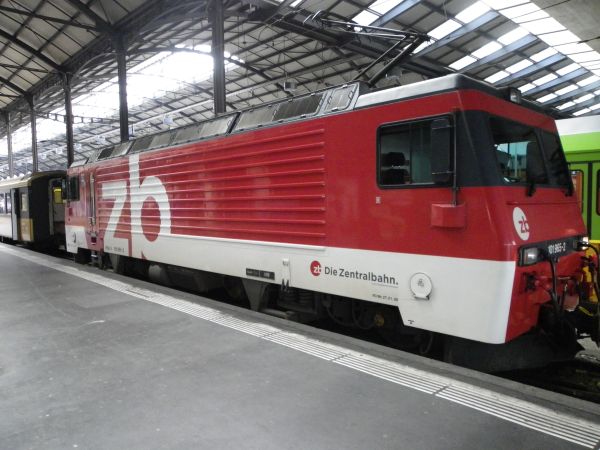
A closer look at one of the HGe 101 locomotives, now in Zentralbahn's colours.
Picture from Luzern Hauptbahnhof 10.7.2010 by Ilkka Siissalo.
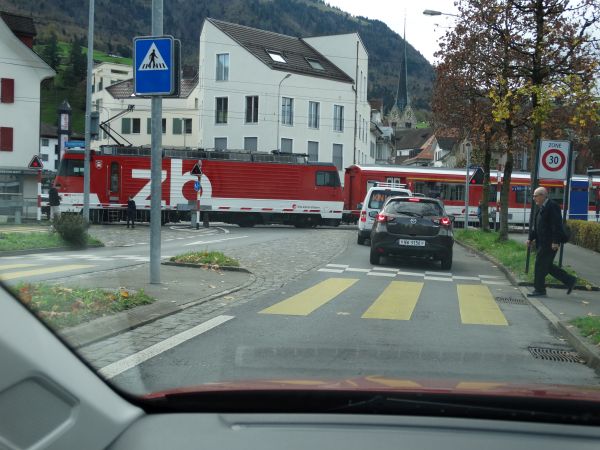
Some of the old HGe 101 locomotives and their old coaches can still be observed in full use. Here a Zentralbahn train led by one of the HGe 101
locomotives is forcing car traffic to stop.
Picture from Stans 4.11.2022 by Ilkka Siissalo.
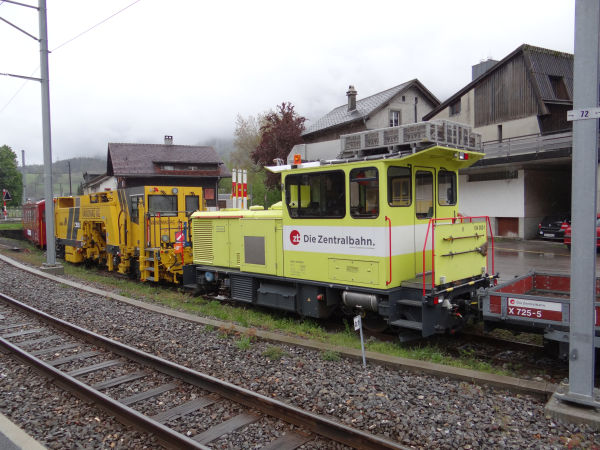
The metre gauge diesel locomotive HGm 104 no.002 seen here with a metre gauge tamper machine of the company Vanomag AG is used for
track maintenance purposes. Zentralbahn has two of these machines and they are from the year 2005. They have also third rail cog
wheel drives of the system Riggenbach so that they can operate on even the steepest slopes of the mountainous lines.
Picture from Meiringen 1.5.2016 by Ilkka Siissalo.
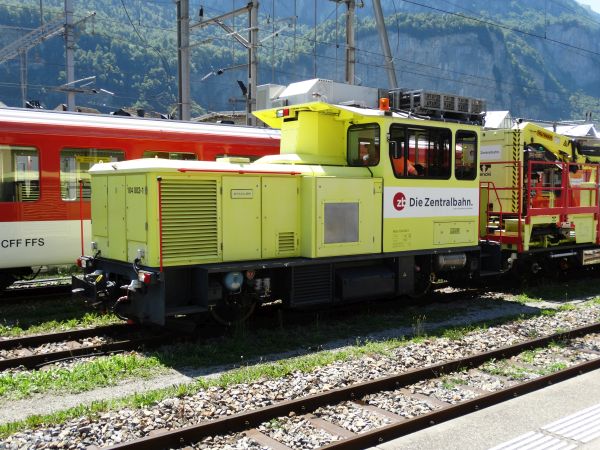
Here the same HGm 104 002 is acting as a powerhorse for a catenary installation and repair train.
Picture from Meiringen 11.7.2023 by Ilkka Siissalo.
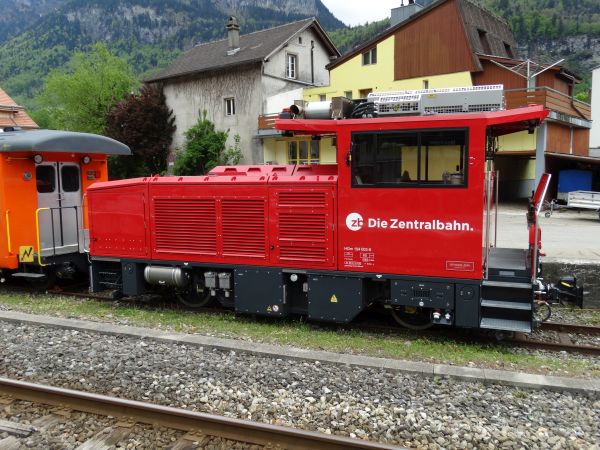
Zentralbahn's brand new HGe 104 switcher diesels are similar but not quite identical with the older yellow HGm 104 001 and 002. These have been
built by Stadler. This is the number 003. These are intended mainly for switching work at the Meiringen station and the adjacent Zentralbahn
depot areas. Due to their diesel power they can operate both on the ZB's 15 kV area as well as under the MIB's 1200 V DC overhead lines.
Picture from Meiringen 13.5.2023 by Ilkka Siissalo.
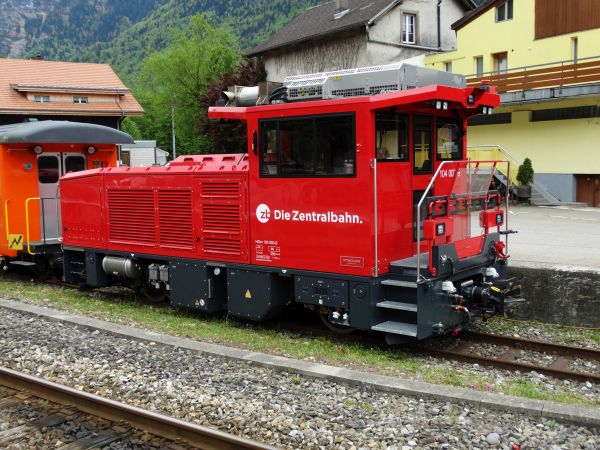
Another view showing better the doorside end of the new locomotive.
Picture from Meiringen 13.5.2023 by Ilkka Siissalo.
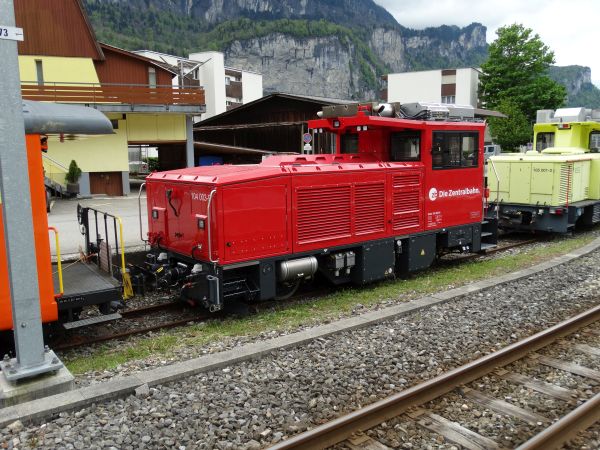
And here the long front of the new locomotive can be better seen. Behind it is for a nice comparison the older Gm 105 no.001. It is otherwise similar
with the older yellow HGm 104 001 and 002 (scroll up to see one) but it is lacking the third rail cog wheel machinery which the others have and which
is needed for operations on the very steep gradients of the Zentralbahn.
Picture from Meiringen 13.5.2023 by Ilkka Siissalo.
Former LSE Luzern-Stans-Engelbergbahn
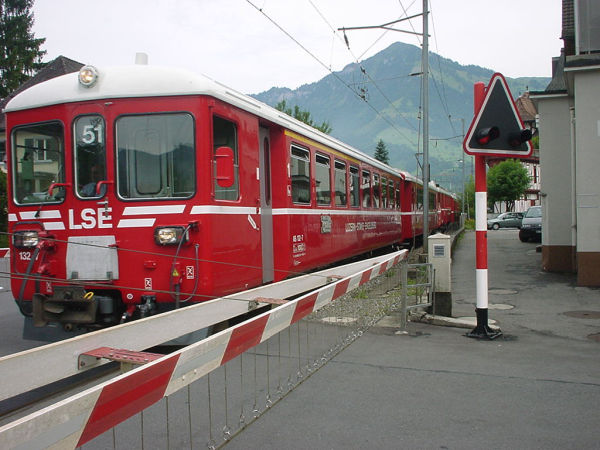
This picture is still from the times of the old LSE Luzern-Stans-Engelbergbahn. This is a flatland service, kind of a suburban
commuter service between Luzern and Stansstad, here arriving at Stansstad.
Picture of a push-pull commuter train of LSE 21.7.2002 at Stansstad by Ilkka Siissalo.
Former MIB Meiringen-Innertkirchen Bahn and its parent organisation, the power plant KWO, Kraftwerk Oberhasli
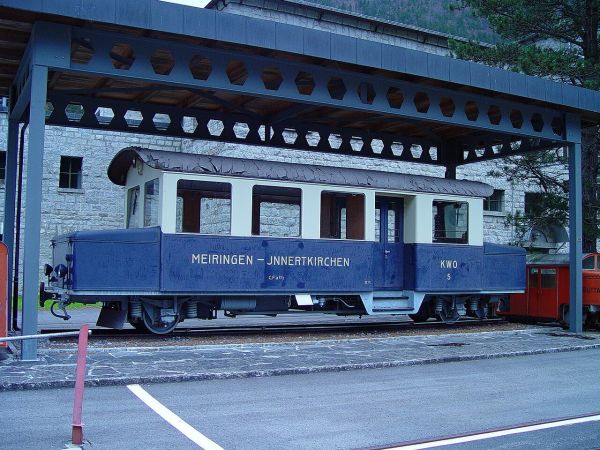
The Meiringen-Innertkirchen Bahn MIB was one of Switzerland's smallest private railroad companies. It's just a 4,99 km long metre gauge
piece of line from Meiringen to Innertkirchen. At Meiringen the line meets the former Brünigbahn line linking Luzern and Interlaken,
now ZB Zentralbahn. Although both the Brünigbahn and the MIB line were both built with metre gauge, their electric systems differed. MIB
uses 1200 V DC whereas the Brünigbahn line is electrified at 15kV AC. The MIB line was initially built just for helping in the construction
of large dams and electric plants at Innertkirchen. The line was opened in 1926. First it used old steam engines bought used from the
Rhätische Bahn. In 1931 a small battery powered motorwagon was bought and it provided the service for a long time after the MIB railway in
1946 got the license to run official passenger traffic. MIB as a company was founded in 1946 and it was a subsidiary of the KWO, a
hydroelectric plant company. Zentralbahn took over the MIB rail services in 2021.
This battery-powered small train CFa 2/2 no.5 took care of all the passenger services on the MIB line from 1931 to 1976, since
1946 as an official and publicly open line, but 1931 to 1946 just as a "factory train" of the power plant of KWO.
Picture from Innertkirchen 27.10.2002 by Ilkka Siissalo.
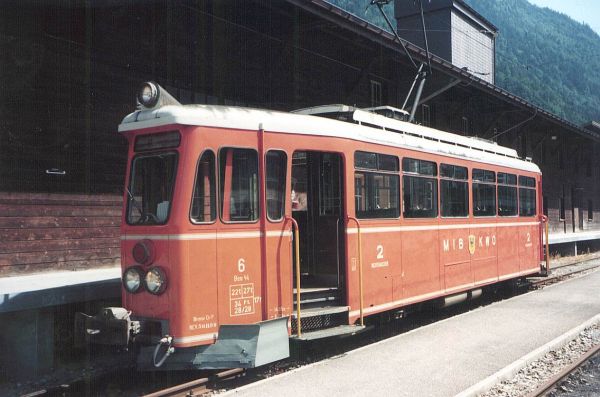
In 1976 it was decided that the MIB line shall be electrified. MIB bought three old tramlike wagons from the Oberrheinischen Eisenbahn-Gesellschaft
OEG. They were from the years 1952 and 1956 and they very much resembled the so called Swiss standard trams. Two of these wagons got in
addition to the electric motors also a small gazoline engine so that they could move also on the Brünigbahn line rails in Meiringen although
the electric systems differed. The third wagon was used just as a spare parts source.
This is one of the tramlike wagons, Bem 4/4 no.6. It had been built by the company Fuchs in Heidelberg, Germany in 1952.
Picture is from Innertkirchen 14.8.1997. It was taken and published by the Wikipedia user "LosHawlos" under the Creative Commons
CC BY-SA 3.0 license
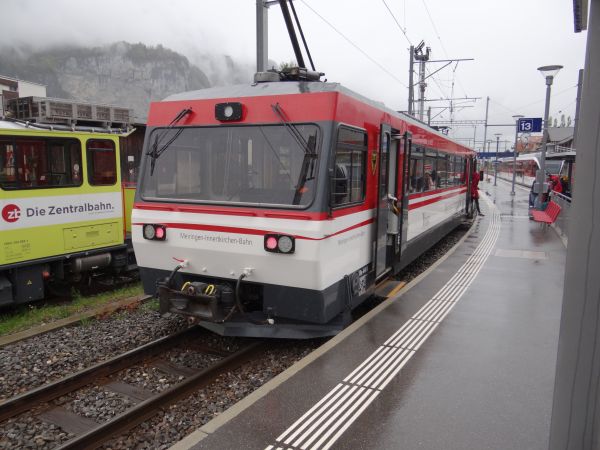
MIB's electric railcar no.8 was built by Stadler in 1996 and for many years it took care of all the traffic between Meiringen and Innertkirchen.
Picture 1.5.2016 from Meiringen by Ilkka Siissalo.
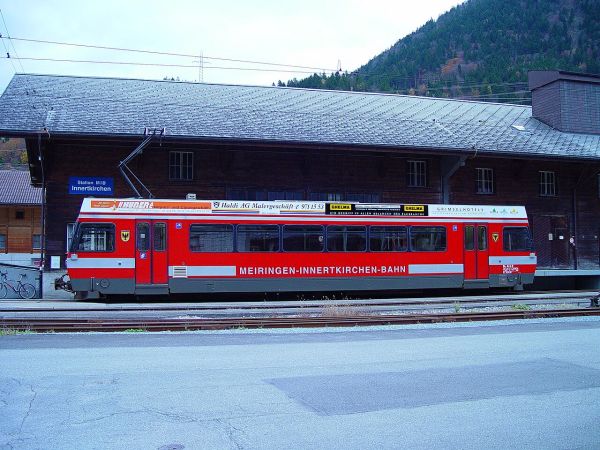
This is how the same motor wagon looked like in 2002 as it was still in its original livery.
Picture from Innertkirchen 27.10.2002 by Ilkka Siissalo.
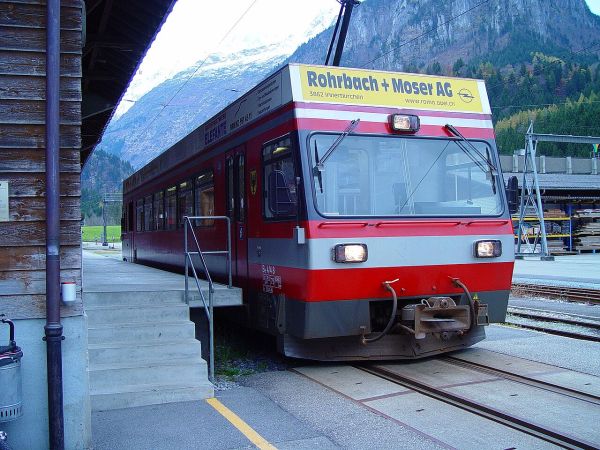
A closer look at the same train in 2002.
Picture from Innertkirchen 27.10.2002 by Ilkka Siissalo.
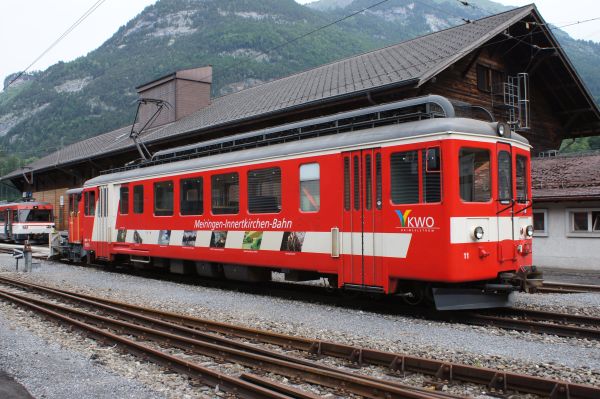
This MIB motorwagon BDe 4/4 no.11 came from the CJ, Chemins de Fer du Jura. It was used as a reserve and was therefore normally only in use
at times when the newer Be 4/4 no.8 shown above was being serviced.
Picture from Innertkirchen 12.6.2015 by Markus Giger, who has published this picture at the Wikipedia under the
Creative Commons CC BY-SA 2.5 ch license.
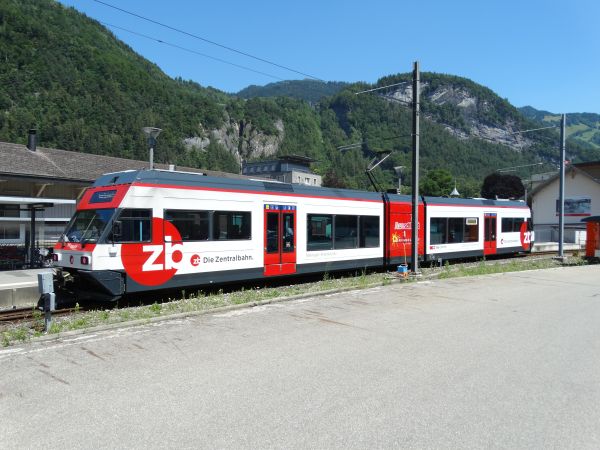
Zentralbahn took over all the passenger train traffic of MIB in 2021 and then they bought this Stadler GTW 2/6 train as a new standard train of the route.
This is actually one of the very oldest GTW trains ever built. It used to belong to the MVR, Transports Montreux-Vevey-Riviera. It is now in
the colours of Zentralbahn, but still numbered as 125 013 according to the old numbering system of MIB.
Picture is from Meiringen 11.7.2023 by Ilkka Siissalo.
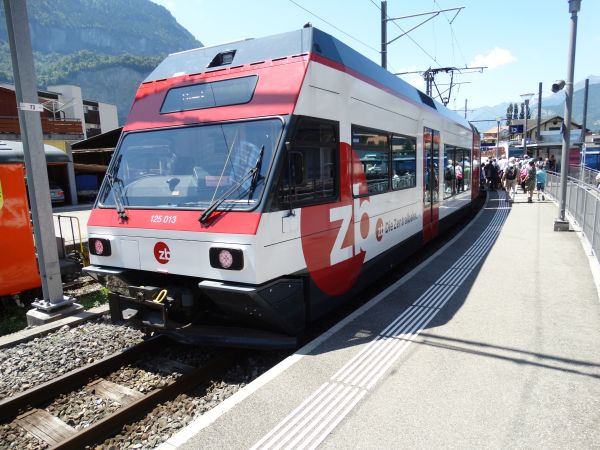
A closer look at the current train on the former MIB route. This train looks almost like new, although it is well over 20 years old already. But
it has been throughly modernised before it started its work on the MIB route.
Picture is from Meiringen 11.7.2023 by Ilkka Siissalo.
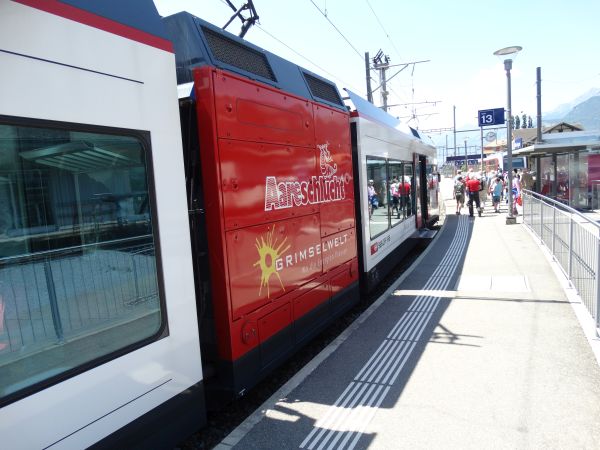
Being a train of the Stadler GTW 2/6 type, this train has all its machinery inside this small power pack. Both of the end wagons are just coaches,
which even lack another bogie so that they are supported by this power pack only in the middle.
Picture is from Meiringen 11.7.2023 by Ilkka Siissalo.
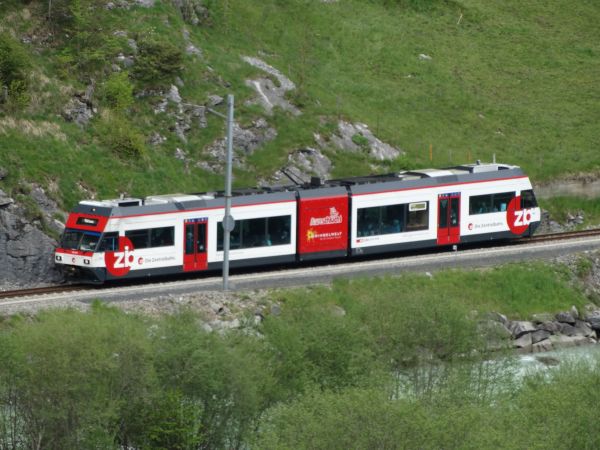
The same GTW 2/6 no 125 013 as shown above, here on the line after just having left the Innertkirchen village towards Meiringen. It will soon reach the
famous mountain gorge of Aareschlucht.
Picture with a long telephoto lens from opposite the Aareschlucht, high up above the village of Innertkirchen 13.5.2023 by Ilkka Siissalo.
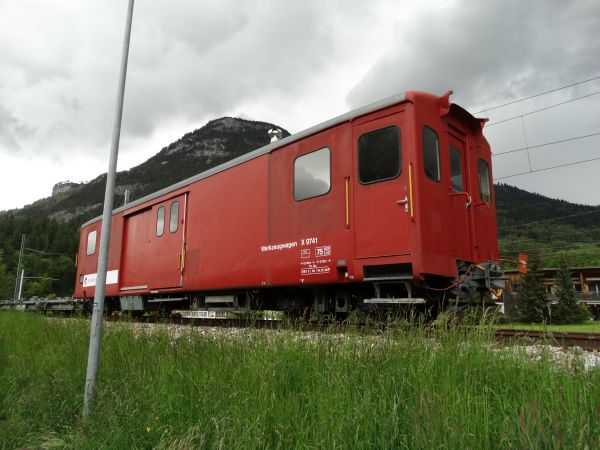
Werkzeugswagen X 9741 or tools wagon parked near the village of Innertkirchen.
Picture from Innertkirchen 13.5.2023 by Ilkka Siissalo.
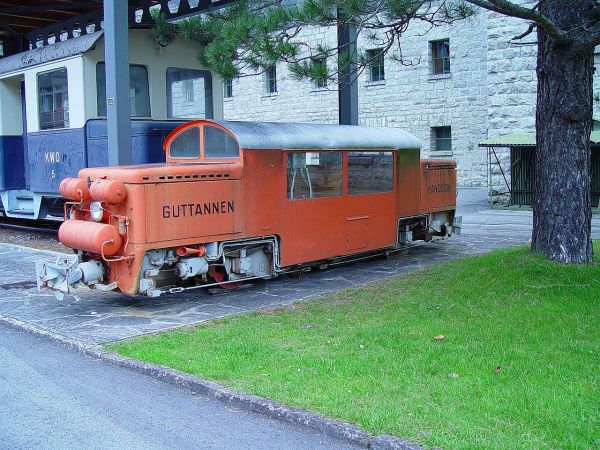
This Guttannen-Handeck so called Stollenlokomotive (tunnel locomotive) of the type Ba 2/2 was never a part of MIB but was owned by KWO, MIB's parent
organisation. It ran in tunnels between those two named villages since 1945. The tunnel networks were taken in use in 1928 and had a strategic military
role during the WW II. Some military equipment was being built under the mountains. The gauge width of these Stollenloks was 500mm. One of them ended
up in front of the Hotel Handeck by the Grimselpass.
Picture from Innertkirchen 27.10.2002 by Ilkka Siissalo.
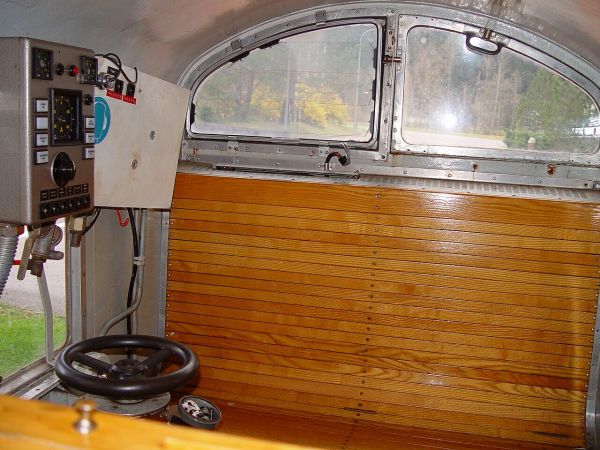
The same Guttannen-Handeck locomotive as above but now seen from inside. Notice how modern this 1943 built machine was. It even had electric windscreen
heating which still today most modern cars are missing.
Picture from Innertkirchen 27.10.2002 by Ilkka Siissalo.
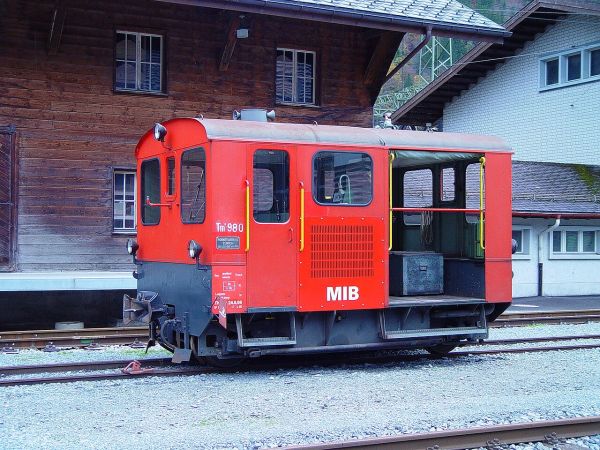
MIB's motor draisine Tm II no. 980. This small one was often used as a locomotive if just one or two wagons had to be moved between Meiringen and
Innertkirchen. The mountain road between these villages runs over a high mountain pass with very steep slopes, so it has been beneficial to use MIB's
trains to move anything heavier.
Picture from Innertkirchen 27.10.2002 by Ilkka Siissalo.
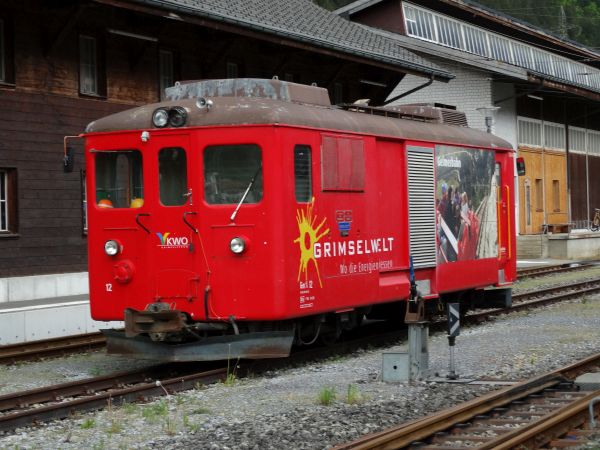
This motor wagon Gem 4/4 no.12 never actually belonged to MIB, but its parent organisation KWO. It's not called a locomotive as it has a large cargo
compartment, but in practise it is a locomotive. This one was bought used from the CJ, Chemins de Fer du Jura.
Picture from Innertkirchen 13.5.2023 by Ilkka Siissalo.
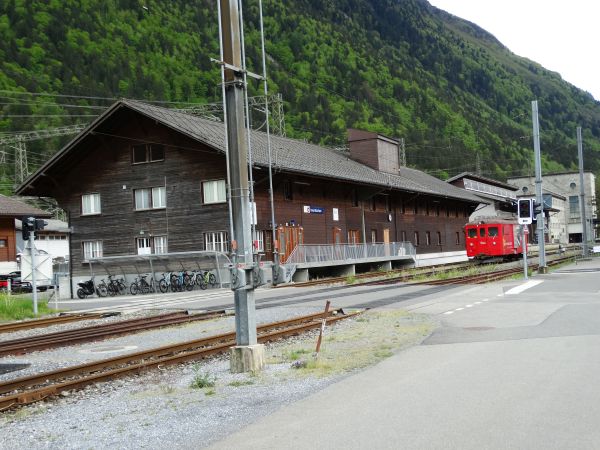
This huge storage house has already for tens of years additionally served as the station house of Innertkirchen. You might recognise the building from many other photos.
In the background the KWO's motor wagon Gem 4/4 no.12.
Picture from Innertkirchen 13.5.2023 by Ilkka Siissalo.
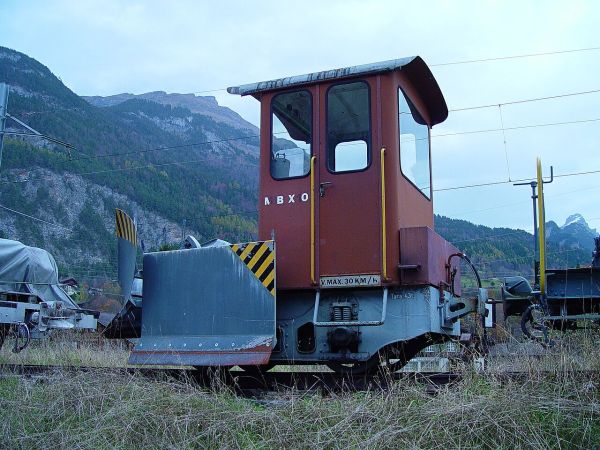
An old snow plough, MIB's X10 in 2002 on a sidetrack between Meiringen and Innertkirchen, fairly close to Innertkirchen.
Picture 27.10.2010 by Ilkka Siissalo.
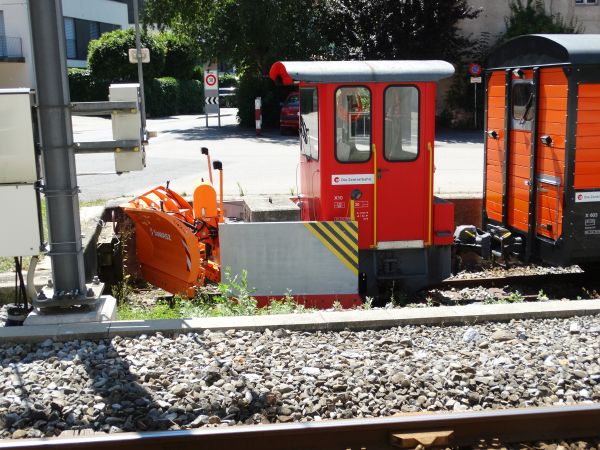
The exactly same snow plough X10 in 2023. It has been thoroughly rehauled, has received new plough parts with video cameras and sensors, a renewed
driver's cab with totally new windows, a new coupling as well as new Zentralbahn's logos and livery.
Picture from Meiringen 11.7.2023 by Ilkka Siissalo.
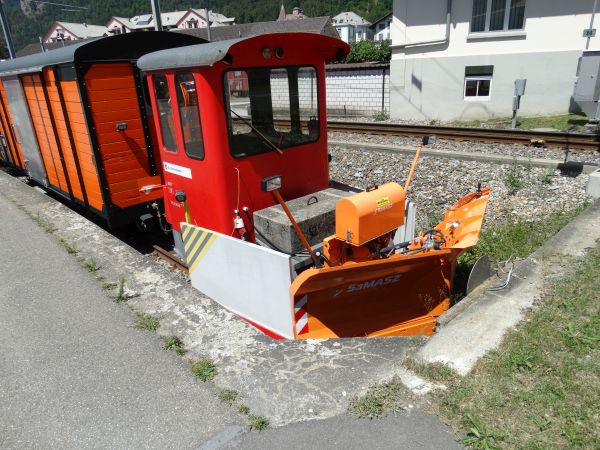
The same modernised snow plough X10 seen now from a little closer by.
Picture from Meiringen 11.7.2023 by Ilkka Siissalo.
Former SBB Brünigbahn
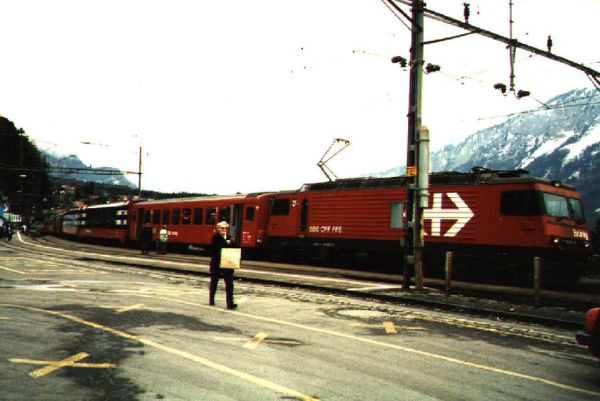
This old picture is still from those times when LSE and Brünigbahn were separate. This was then Brünigbahn's fastest and finest
express train with panorama coaches and a type HGe 4/4 locomotive, here still with large SBB logos on its sides.
Photo by Ilkka Siissalo.
Uploaded May 24, 1999.
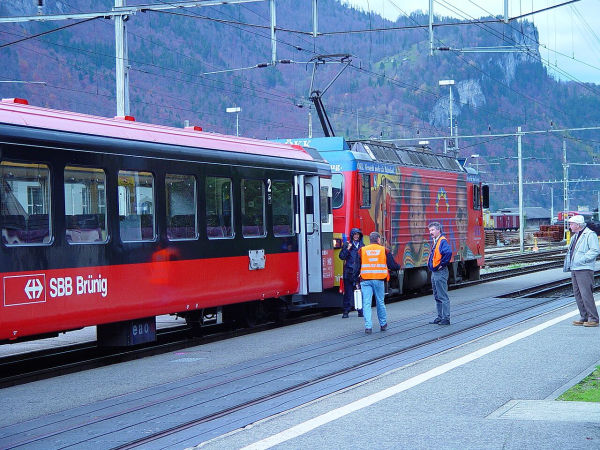
Still from the times when it was SBB Brünigbahn. A train is ready to leave from Meiringen towards Interlaken. But then it was a
rake of old aluminium coaches with an HGe 4/4 locomotive.
Picture from Meiringen 27.10.2002 by Ilkka Siissalo.
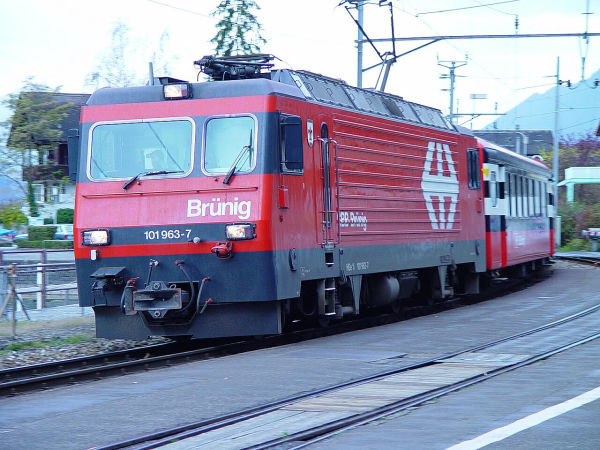
An SBB Brünigbahn train is coming from Interlaken and heading towards Luzern and is here just approaching the station of Brienz.
The locomotive is - of course - again one of the HGe 101 machines.
Picture from Brienz 27.10.2002 by Ilkka Siissalo.
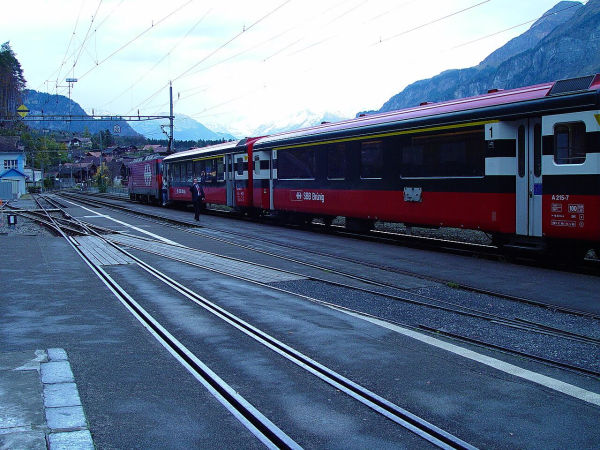
The same train as above, but now after it had stopped at the Brienz station.
Picture from Brienz 27.10.2002 by Ilkka Siissalo.
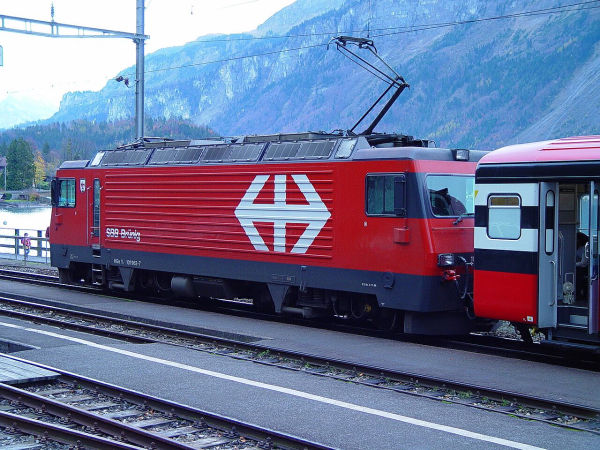
A closer look at the HGe 101 locomotive of the same train as above.
Picture from Brienz 27.10.2002 by Ilkka Siissalo.
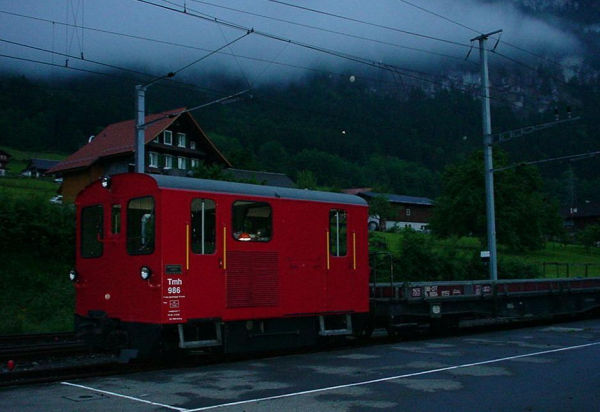
The SBB Brünigbahn narrow gauge combined cog wheel and adhesion railroad small locomotive
Tmh 986 was classified as "cog wheel diesel rail tractor". It was used in maintenance work
on the steep Brünig railroad. Photo from Sarnen station nighttime in June 1999 by
Ilkka Siissalo.
Uploaded June 6th, 2002.
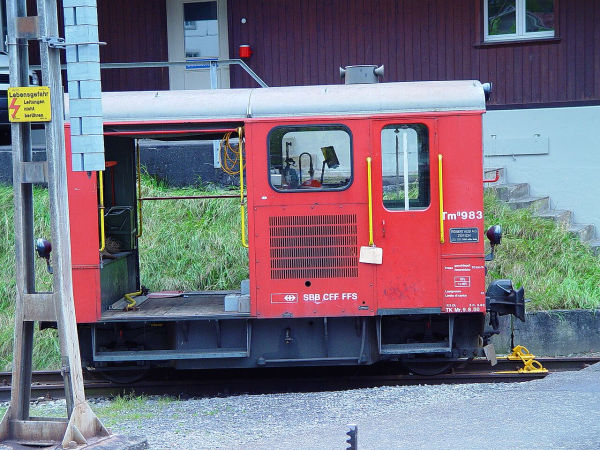
Almost, but not quite similar to the one shown above, the motorised diesel draisine Tm II no.983 was waiting at the Meiringen depot.
Picture from Meiringen 27.10.2002 by Ilkka Siissalo.
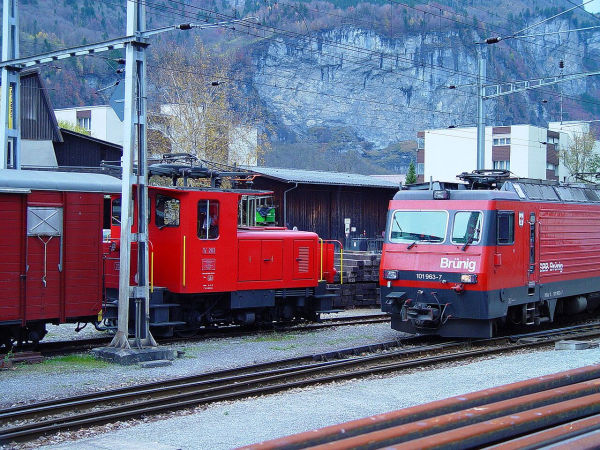
An SBB Brünigbahn class Te III electric rail tractor and an HGe 101 locomotive meeting in Meiringen. Compare the looks of the Te III
with the much later taken photo of Zentralbahn Te 171 shown higher up on this same page.
Picture from Meiringen 27.10.2002 by Ilkka Siissalo.
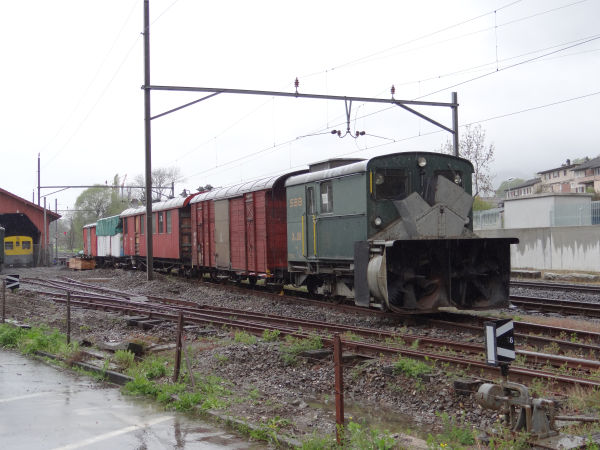
At Alpnahstadt along the Brünig pass railway line there is a small railway museum, which has preserved old equipment from times long gone.
This is a rotary snow plough Xrot e50 used in former times at the Brünig pass mountain line.
Picture from Alpnahstad 1.5.2016 by Ilkka Siissalo.
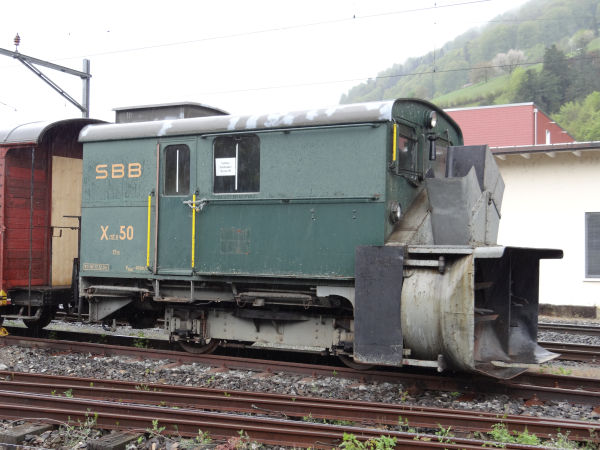
Same rotary snow plough as above.
Picture from Alpnahstad 1.5.2016 by Ilkka Siissalo.
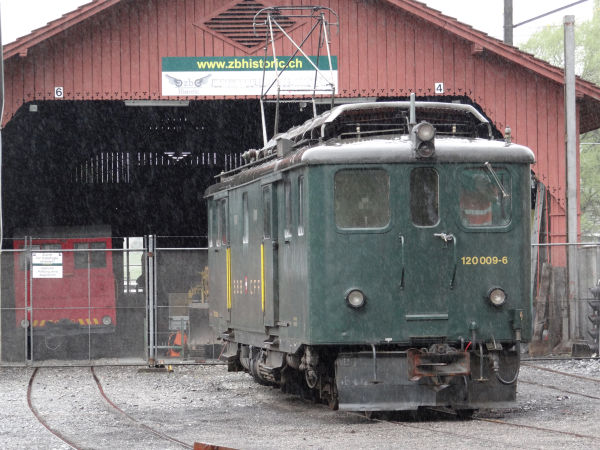
These class Deh 120 locomotives (actually they were classified as "Triebwagen", motor wagon and not a locomotive, because they had cargo
departments) were built during the times of the second world war. This one was built in 1941. They served long times as locomotives
throughout the Brünigbahn route and then later, deprived of their cog wheel mechanisms as locomotives of flat land commuter trains
in the vicinity of Luzern. This one is kept at a museum at Alpnahstad.
Picture from Alpnahstadt 1.5.2016 by Ilkka Siissalo.
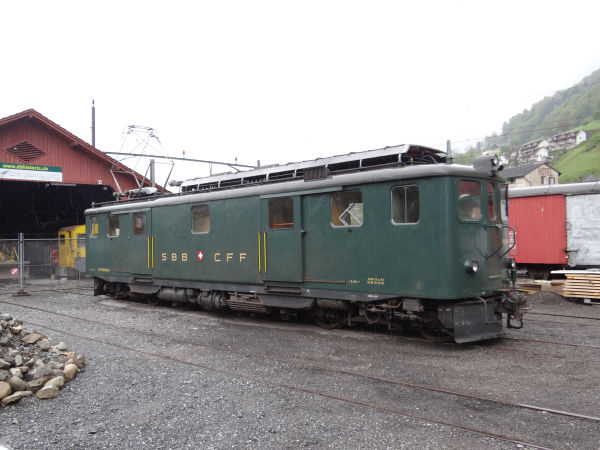
The same Deh 120 "Triebwagen" as above. This one is now again painted in its original green livery. In the 1990s they were still red.
Picture from Alpnahstad 1.5.2016 by Ilkka Siissalo.
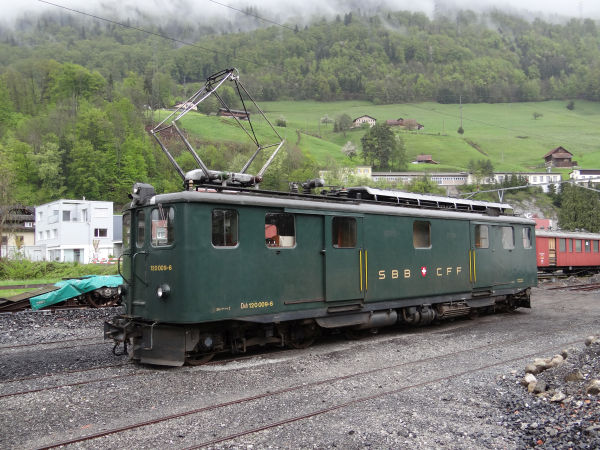
Still the same Deh 120 but seen from the other side.
Picture from Alpnahstad 1.5.2016 by Ilkka Siissalo.
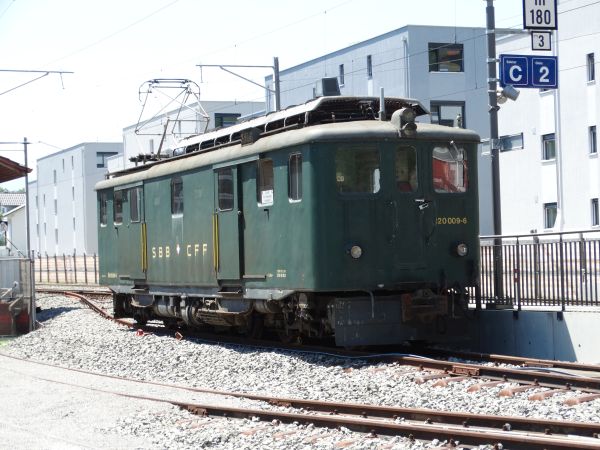
The same Deh120 but now in the year 2023.
Picture from Alpnahstad 11.7.2023 by Ilkka Siissalo.
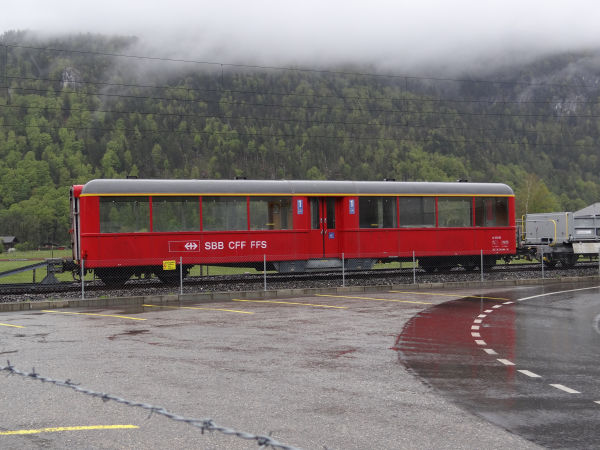
An old first class coach of the former SBB Brünigbahn with large panorama windows sitting idly on a side track near the Meiringen
station. It had several stickers saying "ausrangiert" meaning it has been put out of service.
Picture from Meiringen 1.5.2016 by Ilkka Siissalo.
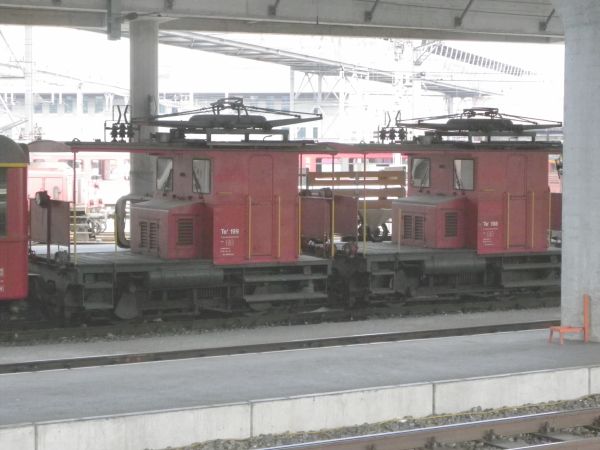
Two old narrow gauge electric switcher tractors of the type Te I. These were built 1941 to 1956 and they were used also by other
narrow gauge Swiss rail companies such as the FO Furka-Oberalpbahn. Here we see them already sidetracked.
Picture from Luzern 10.7.2010 by Ilkka Siissalo.
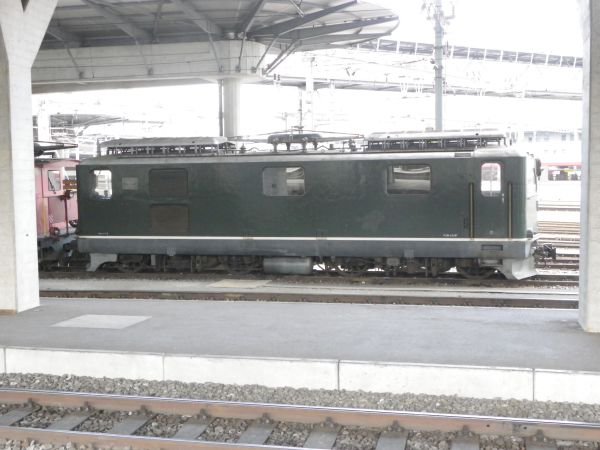
This one is a real rarity. Its a narrow gauge locomotive of the class HGe I. SBB Brünigbahn had two of them and they were built in 1954.
Note the only one pantograph at the center of the machine. These were built so that they could operate either as normal adhesion locomotives
or as rack rail locomotives according to the rack system Riggenbach. They ran with 15 kV AC. Top speed on adhesion tracks was 50 km/h and
30 km/h when using a rack rail. They had the nickname "Muni". This individual was given to the Brünig-Nostalgie-Bahn which then in 2014
renovated it to be again an active and working locomotive.
Picture 10.7.2010 from Luzern by Ilkka Siissalo.
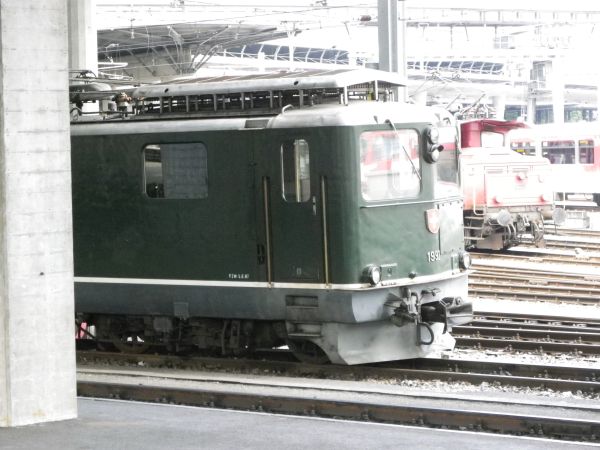
Another picture of the HGe 4/4 I no. 1992 which shows the front of the locomotive a bit better. Note the central coupling and no buffers.
Picture 10.7.2010 from Luzern by Ilkka Siissalo.
The association Brünig Dampfbahn BDB
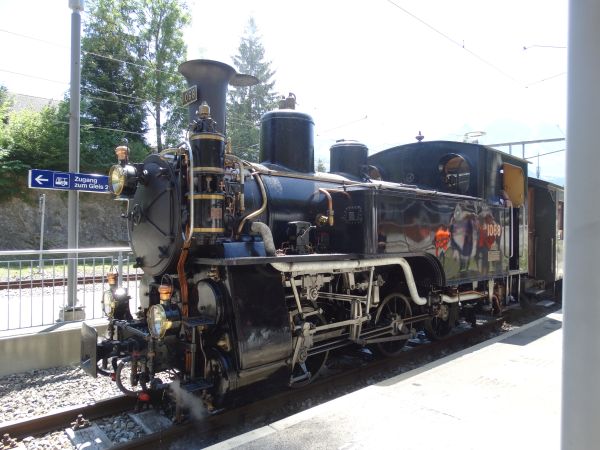
The association Brünig Dampfbahn takes care of historic locomotives and wagons of the former SBB Brünigbahn and also of the Berner Oberlandbahnen BOB.
On the 11th of July 2023 they organised a special train running from Giswil up to the highest point of the Brünig pass, to the station of Brünig
Passhöhe. This locomotive HG 3/3 no. 1068 was the last steam engine of the SBB Brünigbahn. It was built in 1926. It has a top speed of 25 km/h when
running on rack rails and 45 km/h on flatland tracks. For many years this one stood as a monument at the station of Meiringen, but it was taken down
and repaired so that - as you can see - it looks like brand new right now.
Picture from Brünig Passhöhe 11.7.2023 by Ilkka Siissalo.
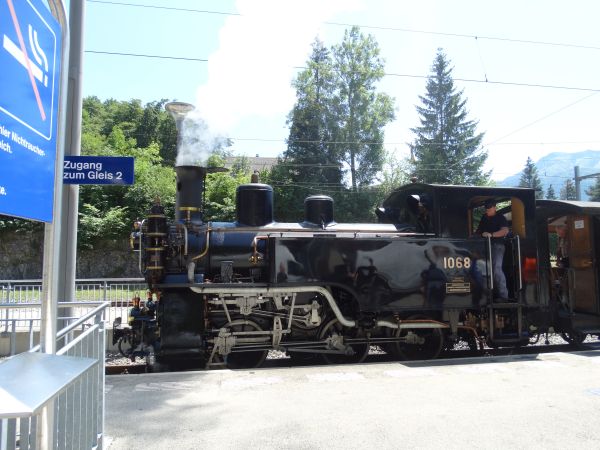
Somebody had really put time and effort in polishing the almost 100 years old locomotive.
Picture from Brünig Passhöhe 11.7.2023 by Ilkka Siissalo.
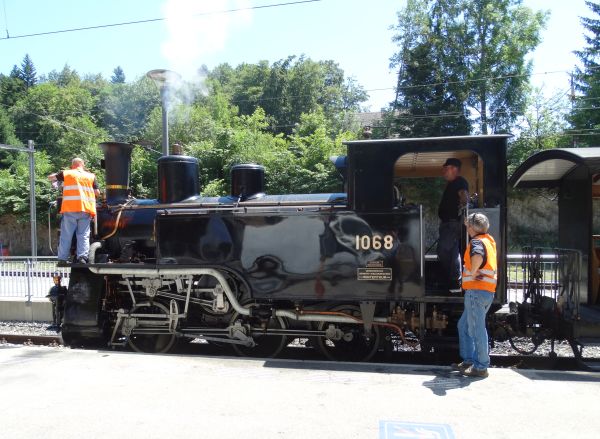
The locomotive still has the original carbide lamp in use. It had to be filled, lit and polished before the locomotive was ready for a return ride back to Giswil.
Picture from Brünig Passhöhe 11.7.2023 by Ilkka Siissalo.
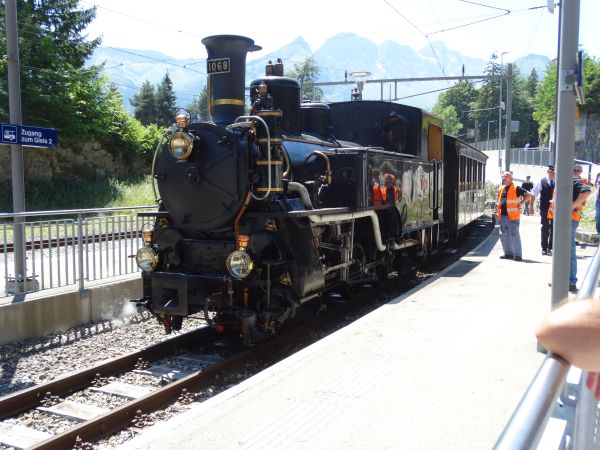
A view from the front. Notice how the side of the locomotive was so well polished that it acts as a mirror.
Picture from Brünig Passhöhe 11.7.2023 by Ilkka Siissalo.
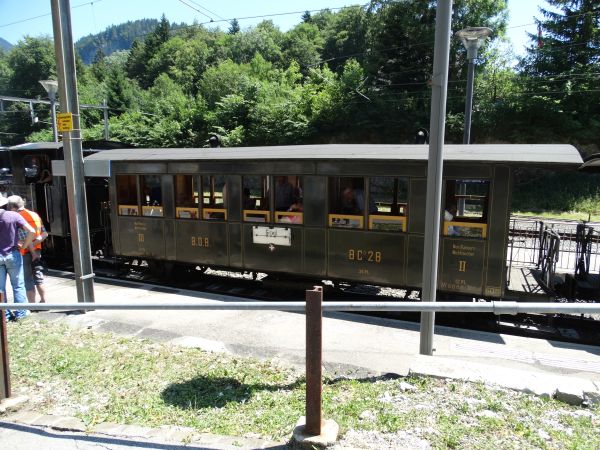
This passenger wagon BC3 no.28 is from the year 1888 and used to belong to the Jura-Bern-Luzern Bahn.
Picture from Brünig Passhöhe 11.7.2023 by Ilkka Siissalo.
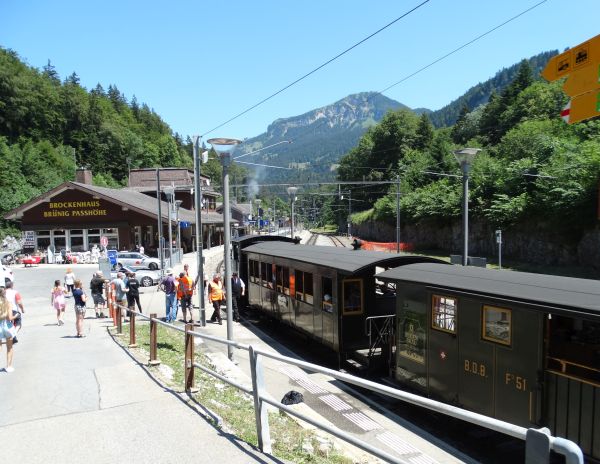
The former postal wagon F3 no.51 from the year 1890 is now a beer restaurant. It used to belong to the Berner Oberland Bahn.
Picture from Brünig Passhöhe 11.7.2023 by Ilkka Siissalo.

